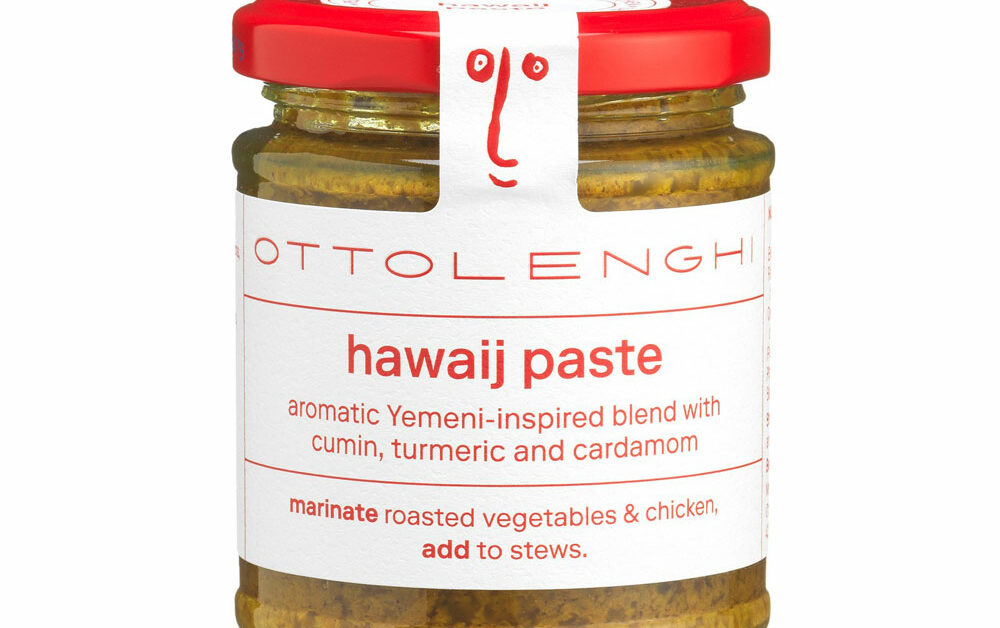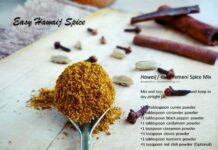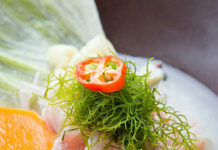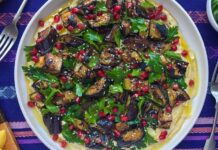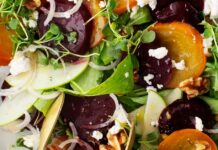If you’re looking to elevate your weeknight dinners with vibrant, bold flavors and a touch of Middle Eastern magic, this Hawaij-Spiced Roasted Veggie Bowl with Tahini Drizzle is exactly what your meal rotation needs.
Inspired by the aromatic RoboFood Hawaij Seasoning, this dish transforms humble vegetables into a fragrant, colorful, and nutrient-rich centerpiece.
The warm, earthy blend of cumin, black pepper, turmeric, and cardamom infuses every bite with depth, while a creamy spiced tahini drizzle ties it all together.
Whether you’re vegetarian, vegan, or just looking to eat more plants, this bowl is satisfying, quick to prepare, and unforgettable in flavor.
Why This Dish Stands Out
There’s something special about the way spices can completely alter the identity of a dish.
With RoboFood Hawaij Seasoning, you’re not just adding heat or salt—you’re layering complexity.
Unlike other spice blends that focus solely on heat or smokiness, Hawaij brings a distinctive warmth and fragrance that’s common in Yemeni cooking but rarely seen in Western kitchens.
By incorporating it into a tahini-based marinade, we’re maximizing its fat-soluble flavor compounds, allowing the oils in tahini to extract every nuance of the blend.
This recipe also champions texture and color.
The roasted vegetables—carrots, bell peppers, zucchini, and red onion—develop a slightly caramelized exterior while maintaining a tender interior.
When paired with fluffy quinoa, protein-rich chickpeas, and a cooling tahini drizzle accented with lemon and garlic, each bite offers a balance of warmth, creaminess, and freshness.
Plus, it’s naturally vegan and gluten-free, making it accessible for a variety of dietary needs.
The Magic of RoboFood Hawaij Seasoning
At the heart of this dish is RoboFood Hawaij Seasoning, a traditional Yemeni spice mix that’s both rustic and refined.
Let’s break down its components:
- Cumin – Adds an earthy, nutty base note that enhances the natural sweetness of roasted vegetables.
- Black pepper – Delivers a subtle heat and enhances the bioavailability of other spices, like turmeric.
- Turmeric – Brings a golden hue and anti-inflammatory properties, along with a gentle bitterness that complements richness.
- Cardamom – Offers a citrusy, almost floral aroma that elevates the entire blend, giving it a unique perfume.
Together, these spices form a synergy that’s greater than the sum of their parts.
They don’t compete—they collaborate.
And when suspended in a tahini marinade, they evenly coat every vegetable surface, ensuring consistent flavor in every bite.
Choosing the Right Vegetables
One of the strengths of this recipe is its flexibility.
While we recommend carrots, bell peppers, zucchini, and red onion for their complementary textures and colors, feel free to swap in sweet potatoes, cauliflower, eggplant, or even cherry tomatoes (added halfway through roasting to prevent mushiness).
To ensure even roasting:
- Cut vegetables into uniform sizes—about 1-inch pieces.
- Toss them thoroughly with the marinade so each piece is evenly coated.
- Spread on a large baking sheet in a single layer. Crowding causes steaming, not roasting.
- Use parchment paper or a silicone mat to prevent sticking and promote easier cleanup.
For the best texture, we recommend roasting at 425°F (220°C).
This high heat encourages browning and caramelization, which develops deeper flavor through the Maillard reaction.
After about 25–30 minutes, the vegetables should be tender with crisp, golden edges.
Creating the Spiced Tahini Marinade
What sets this recipe apart is the dual use of Hawaij seasoning—not just a sprinkle on top, but a key ingredient in the marinade itself.
Tahini, made from ground sesame seeds, has a rich, nutty base that pairs perfectly with the warm spices.
Here’s how to build the marinade:
- Start with 1/4 cup of well-stirred tahini (sesame oil often separates, so mix it thoroughly).
- Add 3 tablespoons of fresh lemon juice for brightness and to balance the earthiness.
- Whisk in 2 tablespoons of olive oil to smooth the texture.
- Add 1 teaspoon of RoboFood Hawaij Seasoning—this is the flavor anchor.
- Include 1 minced garlic clove for a savory kick (optional but recommended).
- Thin with 2–3 tablespoons of warm water until it reaches a pourable consistency.
This isn’t just a coating—it’s an infusion.
Let the vegetables marinate for at least 15 minutes before roasting, or up to 30 minutes for deeper flavor penetration.
The longer they sit, the more the spices interact with the natural sugars in the vegetables, enhancing the complexity once roasted.
Building the Bowl
The assembly is where creativity shines.
Start with a base of cooked quinoa or your preferred grain—couscous, farro, or brown rice work beautifully.
Then layer:
- Roasted Hawaij-spiced vegetables
- Warm or room-temperature chickpeas (tossed lightly with extra Hawaij for cohesion)
- A drizzle of the remaining tahini sauce
- Fresh herbs like parsley or cilantro for brightness
- A sprinkle of sumac or lemon zest for extra tang
- Toasted sesame seeds or chopped almonds for crunch
Additions like pickled red onions, olives, or a dollop of labneh (if not strictly vegan) can elevate the dish further.
It’s not just a bowl—it’s a culinary canvas.
Why Tahini Works So Well with Hawaij
Tahini isn’t just a trendy ingredient—it’s a staple in Middle Eastern pantries for good reason.
Its high fat content makes it an ideal medium for carrying fat-soluble spices like cumin and turmeric.
When mixed with Hawaij, the tahini becomes more than a sauce—it becomes a flavor amplifier.
Additionally, the slight bitterness of tahini balances the warmth of the spices, preventing the dish from feeling overwhelming.
The lemon juice adds acidity, which cuts through the richness and keeps the bowl feeling light despite its intensity.
Meal Prep and Storage Tips
This bowl is perfect for meal prep.
Roast the vegetables and cook the grain ahead of time, storing them separately in airtight containers in the refrigerator for up to 4 days.
The tahini sauce can be made in advance and refrigerated—just thin with a little water or lemon juice before serving if it thickens.
Reheat components gently in the microwave or on the stovetop.
For best texture, consider refreshing the vegetables in a skillet or oven to restore crispness.
The chickpeas can be warmed in a dry pan to bring out their nutty flavor.
Customization Ideas
Want to make this bowl your own?
Here are some ideas:
- Protein boost: Add grilled halloumi, falafel, or shredded chicken marinated in additional Hawaij.
- Spice level: For extra heat, add a pinch of cayenne or a few drops of harissa to the tahini sauce.
- Greens: Serve over a bed of arugula or spinach for freshness and added nutrients.
- Sweet contrast: Include roasted pears or apples for a surprising flavor twist.
The beauty of this recipe lies in its adaptability.
It’s not about rigid rules—it’s about celebrating bold, aromatic flavors in a way that suits your palate.
Pairing Suggestions
While this bowl stands well on its own, it pairs beautifully with a chilled mint-cucumber yogurt drink (doogh) or a simple arugula salad with lemon vinaigrette.
For a heartier meal, serve alongside warm pita bread or flatbread for dipping into leftover sauce.
Wine enthusiasts might enjoy a crisp white like Sauvignon Blanc or Assyrtiko, whose bright acidity complements the spices and tahini.
Non-alcoholic options include sparkling pomegranate juice or hibiscus tea, both of which offer fruity tang that balances the earthiness.
Final Thoughts
In a world where spice blends often feel interchangeable, RoboFood Hawaij Seasoning stands apart.
This roasted veggie bowl isn’t just delicious—it’s an invitation to explore Yemeni flavors from your own kitchen.
It’s proof that plant-based meals can be deeply flavorful, satisfying, and exciting without relying on meat or heavy dairy.
By building the flavor from the ground up—using Hawaij in the marinade, seasoning the chickpeas, and finishing with extra on the side—you’re creating layers of taste that keep you coming back for more.
And as more people seek global inspiration in their cooking, dishes like this help bring underrepresented cuisines into the spotlight.
So next time you’re wondering what to make for dinner, skip the bland and go bold.
Let Hawaij take the lead, and let tahini smooth the way.
Your taste buds—and your dinner table—will thank you.

